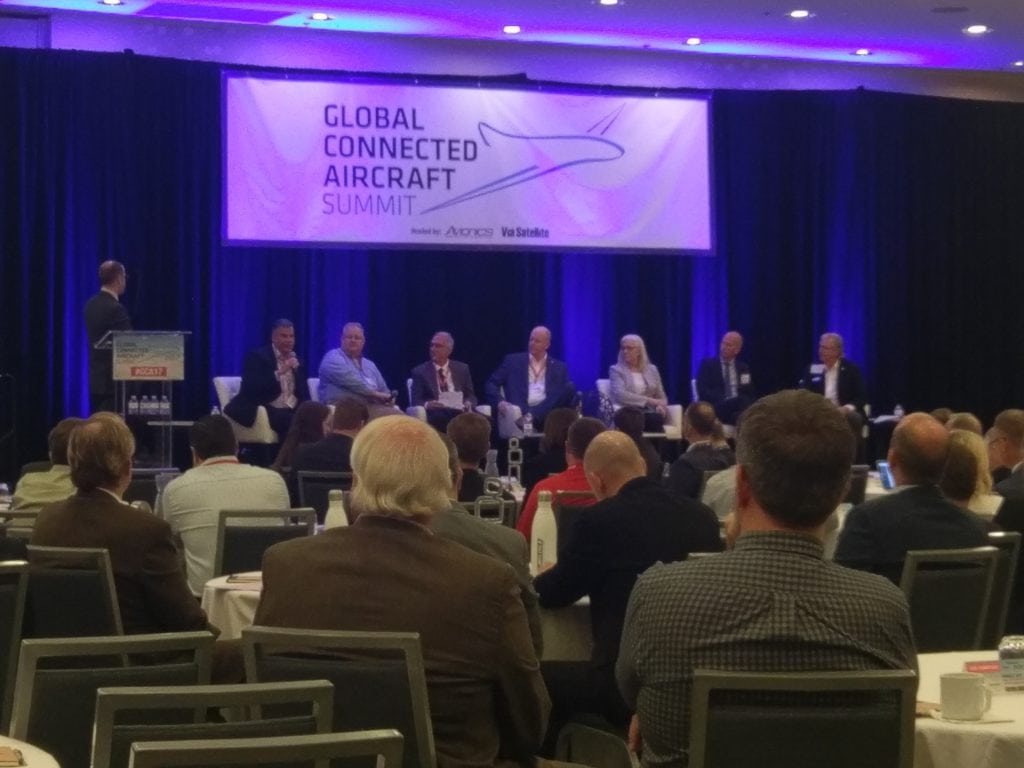
Passengers are not the only ones that can make use of inflight connectivity. The most effective use of internet protocol (IP) capability may be in the cockpit — not the cabin. During the Global Connected Aircraft Summit, a panel of airlines and service providers discussed developments, uses, benefits and challenges surrounding the “connected” cockpit.
During the panel, “Operations 2.0: EFBs, Weather Applications, and Flight Tracking Assessed,” panelists touched on a variety of subjects, from app development, to weather, to chat and beyond. As the technology keeps developing, more uses for cockpit connectivity become applicable. But, there are three key obstacles to unlocking full potential: spectrum, streams of data and security.
Capt. Mary McMillan, VP of Safety and Operational Services for Inmarasat Global Ltd., emphasized the need for smart use of spectrum. The company works in some countries, she said, where there is no available very high frequency (VHF).
“I think it’s really key and important that we actually use the spectrum that’s fit for purpose,” McMillan said. “I think that’s one of the questions we have to ask ourselves: What data are we going to pull off of the aircraft, and what channel are we going to use?”
To combat the problem, McMillan said the company is looking to use multiple spectrum bands. Inmarsat is exploring what fit-for-purpose activities it can maximize the spectrum for.
The goal of the connected cockpit is to pull large amounts of data off the aircraft in real time. But if there is too much data to sift through efficiently and effectively, the benefits cannot be fully realized. In fact, it could be overwhelming. Capt. Ross C. Armstrong, fleet technical pilot for FedEx Flight Operations, said that was one of the driving factors that led the company to implement an aircraft information server. It allows data to be stored and disseminated into what is most important, and what data requires an action. Mark Spence, president of WxOps Inc., noted that data from connected cockpits could be most useful for forecasting.
“If you think about it: preflight, you have applicability; inflight, you have applicability; and forensics after the flight,” Spence said. “You need to think about the forensics after the fact, and connectivity allows you to do that. I think the NTSB had it right: You don’t use the EFB for driving the airplane; you use the instrumentation on the airplane. But strategically, what’s down the road, … training — that’s where I see the connected cockpit being very helpful.”
But even with an efficient way to collect and disseminate data, there is still one important element let to ensure. Is the data protected? Is the data vulnerable to unwanted and uninvited manipulation? Cybersecurity is a major concern in the aviation industry. In March, the FAA told attendees at an unmanned aircraft system (UAS) summit that the agency could not conquer the subject without the help of industry. And for Delta Airlines, at least, cybersecurity cannot be conquered without millennials. Roland Brenny, principal of Information Technology, Flight Crew, Catering and Technical Operation Applications for Delta, said that taking standard cybersecurity procedures and applying them without customization, is not the most efficient way to problem solve.
“We are taking the standard internet solutions, and giving a solution to a very particular type of problem. [This] is probably a good thing and a not-so-good thing,” Brenny said. “We’re so centric on the aircraft itself, and, at least at Delta, we are hiring people who are all millennials. [To them], the internet has always been available; iPhones have always been available.”
Although millennials may not have decades of experience in aviation, Brenny explained that they have the innate ability to work within connectivity, simply from growing up with it.
“It’s an eye opening experience for anyone starting — whether you’re coming from an IT background, a business background — and they start asking questions like, ‘Why can’t you do this?’” he said.
There is still a long way to go, in terms of development, until the full potential of cockpit connectivity is unlocked.
“We are kind of the new kid on the block using the internet,” said Thomas Lunding, fleet chief pilot of the A330/A340 for Scandinavian Airlines. “And there aren’t that many cockpits that are allowed to use Wi-Fi yet. You need a solution with old-fashion wire to hook up things if you are incorporating it into old cockpits.”
Even if slowly, the airline industry has started developing ways to unlock that full potential. And that means finding ways to overcome the challenges.